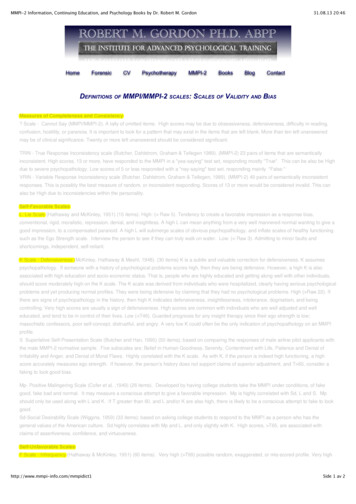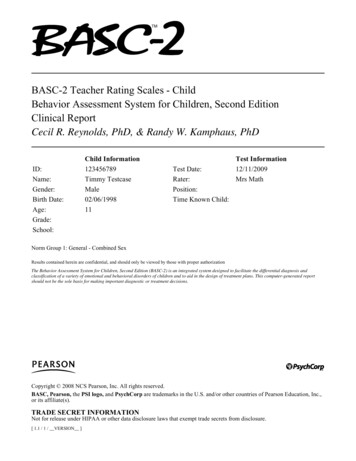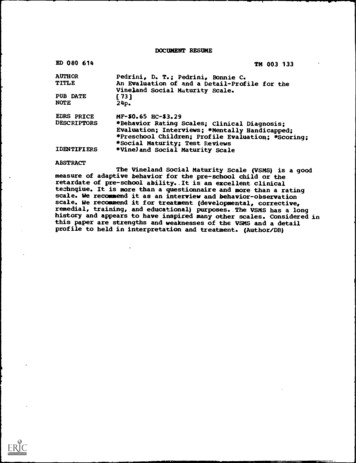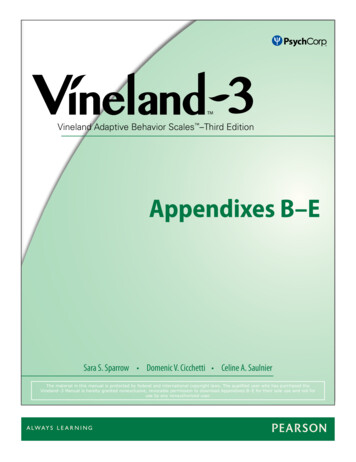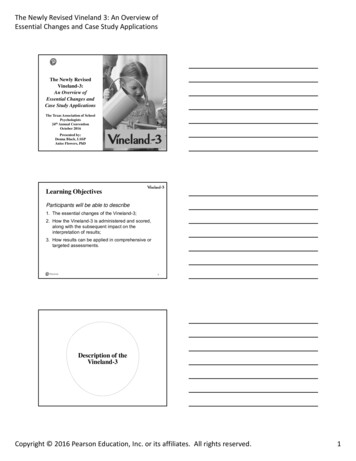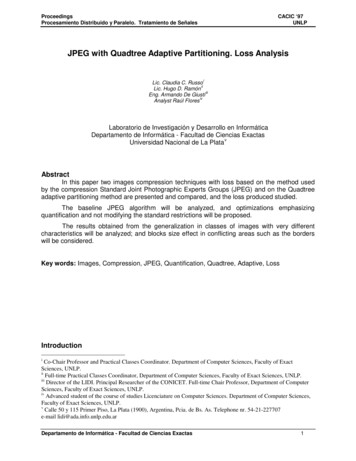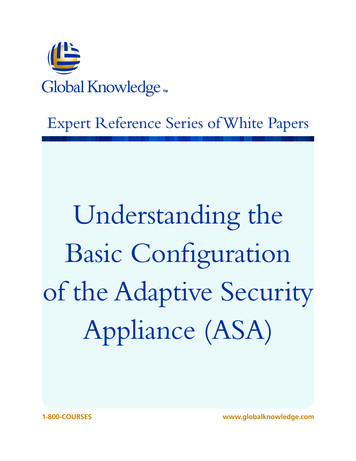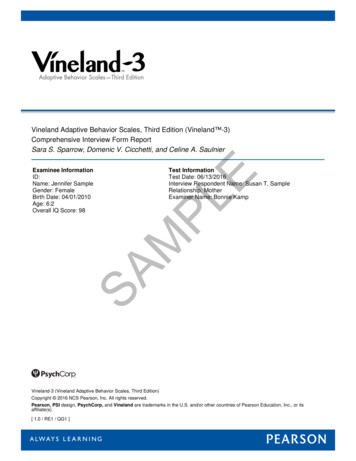
Transcription
Vineland Adaptive Behavior Scales, Third Edition (Vineland -3)Comprehensive Interview Form ReportSara S. Sparrow, Domenic V. Cicchetti, and Celine A. SaulnierPLETest InformationTest Date: 06/13/2016Interview Respondent Name: Susan T. SampleRelationship: MotherExaminer Name: Bonnie KampSAMExaminee InformationID:Name: Jennifer SampleGender: FemaleBirth Date: 04/01/2010Age: 6:2Overall IQ Score: 98Vineland-3 (Vineland Adaptive Behavior Scales, Third Edition)Copyright 2016 NCS Pearson, Inc. All rights reserved.Pearson, PSI design, PsychCorp, and Vineland are trademarks in the U.S. and/or other countries of Pearson Education, Inc., or itsaffiliate(s).[ 1.0 / RE1 / QG1 ]
Comprehensive Interview Form ReportPage 2Jennifer SampleOVERALL SUMMARYThe Vineland-3 is a standardized measure of adaptive behavior--the things that people do to function in theireveryday lives. Whereas ability measures focus on what the examinee can do in a testing situation, theVineland-3 focuses on what he or she actually does in daily life. Because it is a norm-based instrument, theexaminee's adaptive functioning is compared to that of others his or her age.Jennifer Sample was evaluated using the Vineland-3 Comprehensive Interview Form on 06/13/2016. Susan T.Sample, Jennifer's mother, was interviewed by Bonnie Kamp, who completed the form.Jennifer's overall level of adaptive functioning is described by her score on the Adaptive Behavior Composite(ABC). Her ABC score is 83, which is somewhat below the normative mean of 100 (the normative standarddeviation is 15). The percentile rank for this overall score is 13.EThe ABC score is based on scores for three specific adaptive behavior domains: Communication, Daily LivingSkills, and Socialization. The domain scores are also expressed as standard scores with a mean of 100 andstandard deviation of 15.PLThe Communication domain measures how well Jennifer listens and understands, expresses herself throughspeech, and reads and writes. Her Communication standard score is 92. This corresponds to a percentile rank of30.The Daily Living Skills domain assesses Jennifer's performance of the practical, everyday tasks of living that areappropriate for her age. Her standard score for Daily Living Skills is 79, which corresponds to a percentile rank of8. This domain is a relative weakness for Jennifer.SAMJennifer's score for the Socialization domain reflects her functioning in social situations. Her Socializationstandard score is 90. The percentile rank is 25.
Comprehensive Interview Form ReportPage 3Jennifer SampleSCORE SUMMARY PROFILEABC and Domain Score ProfileSubdomain v-Scale Score ProfileBased on mean of 100, SD of 15Based on mean of 15, SD of rsonalRelationshipsPlay and LeisureCoping SkillsGross MotorFine Motorv-ScaleScoreCommunity87 - 97 74 - 84 85 - 95 90 - 104Domestic97PersonalMotor nicationMotorSkillsExpressive80 - 86921Daily LivingSkillsReceptiveConf Int90%83Daily viorComposite1131612148121514111811
Comprehensive Interview Form ReportPage 4Jennifer SampleSCORE SUMMARYABC and Domain Score SummaryStandardScore (SS)90% ConfidenceIntervalPercentile Rank8380 - 8613Communication9287 - 97302.5Daily Living Skills7974 - 848-10.5Socialization9085 - 95250.5Motor Skills9790 - 104427.5ABCAdaptive BehaviorCompositeSS MinusMean SS*Strength orWeakness**Base RateWeakness 15%Strength 25%DomainsE*The examinee's Mean Domain Standard Score (Mean SS) 89.5**Significance level chosen for strength/weakness analysis is .10Raw Scorev-ScaleScore ( sCommunicationDomainPLSubdomain Score SummaryAgeGrowthEquivalent Scale ValuePercentEstimatedvS MinusMean vS*-0.1Strength orBase 1320.00.98 :61090.00.929112:8620.0-2.1Gross Motor86188:10 1910.04.9Strength 5%Fine Motor48114:41360.0-2.1Weakness 25%Daily Living ength 10%Weakness 2%Strength 25%Weakness 25%Socialization DomainInterpersonalRelationshipsPlay and LeisureCoping SkillsMotor Skills Domain*The examinee's Mean Subdomain v -Scale Score (Mean vS) 13.1**Significance level chosen for strength/weakness analysis is .10
Comprehensive Interview Form ReportPage 5Jennifer SamplePAIRWISE DIFFERENCE COMPARISONSDomain Pairwise Difference ComparisonsIn the table below the first domain corresponds to Standard Score 1 and the second domain corresponds toStandard Score 2.Standard Score1Standard Score2Standard ScoreDifferenceSignificantDifference*Base RateCommunication Daily LivingSkills927913.0Yes 25%Communication Socialization92902.0NoDaily Living Skills Socialization799011.0YesCommunication Motor Skills92975.0NoDaily Living Skills Motor Skills799718.0YesSocialization Motor Skills90977.0NoComparisonDomainsPLSubdomain Pairwise Difference Comparisons 25%E*Significance level chosen for pairwise difference comparisons is .10 25%In the table below the first subdomain corresponds to v-Scale Score 1 and the second subdomain corresponds tov-Scale Score 2.v-Scale Score 1Communication DomainReceptive ExpressiveReceptive WrittenExpressive Writtenv-Scale ScoreDifferenceSignificantDifference*Base Rate 25%13163.0Yes13121.0No16124.0Yes 15% 2%SADaily Living Skills Domainv-Scale Score 2MComparisonPersonal Domestic1486.0YesPersonal Community14122.0NoDomestic Community8124.0YesInterpersonal Relationships Play and Leisure15141.0NoInterpersonal Relationships Coping Skills15114.0Yes 15%Play and Leisure Coping Skills14113.0Yes 25%18117.0Yes 5% 15%Socialization DomainMotor Skills DomainGross Motor Fine Motor*Significance level chosen for pairwise difference comparisons is .10
Comprehensive Interview Form ReportPage 6Jennifer SampleMALADAPTIVE BEHAVIOR RESULTSMaladaptive ScaleRaw Scorev-Scale ScoreInternalizing115Externalizing1020v-scale scores have a mean of 15, SD of 3Critical Items Scored 2 (Often) or 1 (Sometimes)SAMPLE10. Shows excessive interest in weapons or violence. (Sometimes)17. Threatens to hurt or kill someone. (Sometimes)
Comprehensive Interview Form ReportPage 7Jennifer SampleABOUT THE VINELAND-3 SCORESThe Vineland-3 score interpretation that follows describes the results presented on the previous pages using anarrative format. This section provides a brief overview of the scores and analyses that are included in theinterpretation. Please consult the Vineland-3 Manual for more detail.The Vineland-3 Comprehensive Interview Form provides norm-referenced scores at three levels: subdomains,domains, and the overall Adaptive Behavior Composite (ABC). Adaptive behavior subdomains make up the mostfine-grained score level. The primary norm-referenced scores for the subdomains are v-scale scores, which havea mean of 15 and standard deviation (SD) of 3. The v-scale score for each subdomain is included in the narrativeinterpretation below. Raw scores, age equivalents, and growth scale values, though shown in the SubdomainScore Summary on page 4, are not included in the interpretation; please consult the Manual for information aboutthese scores.PLEFor the adaptive behavior domains and the overall ABC, three kinds of results are provided on page 4 andincluded in the interpretation below. Standard scores have a mean of 100 and SD of 15. Confidence intervalsreflect the effects of measurement error and provide, for each standard score, a range within which Jennifer's truestandard score falls with a certain probability or confidence. The confidence level chosen for this report is the90% confidence interval. A percentile rank is the percentage of individuals in Jennifer's normative age groupwho scored the same or lower than Jennifer. For example, a percentile rank of 41 indicates that the examineescored higher than (or the same as) 41% of the age-matched norm sample.Strength/Weakness and Pairwise Difference ComparisonsMThe norm-referenced scores included in the narrative interpretation describe how Jennifer's adaptive functioningcompares to that of others in her age group. Two other components of the interpretation address the extent towhich Jennifer's functioning may be relatively better in some adaptive behavior areas than in others, regardless ofher overall level. These analyses--strength/weakness analysis and pairwise difference comparisons--help identifyways in which the score variation within Jennifer's score profile is statistically meaningful, and therefore morelikely to be important in interpreting and using her Vineland-3 results.SAStrength/weakness analysis involves comparing each score (standard scores at the domain level, v-scale scoresat the subdomain level) to the mean of all scores (these results are included in the tables on page 4). Scores thatare greater than the mean by a statistically significant amount indicate strengths, and scores that are less than themean by a statistically significant amount indicate weaknesses.Pairwise difference comparisons provide information that complements the findings from strength/weaknessanalysis. At the domain level, each standard score is compared with every other standard score. At thesubdomain level, selected pairs of subdomain v-scale scores are compared, as shown in the table on page 5.Each pairwise score difference is evaluated for statistical significance.The significance level chosen for strength/weakness analysis and pairwise difference comparisons inthis report is .10. Though not included in the interpretation below, each statistically significant strength,weakness, or pairwise score difference is associated with a base rate in the tables on pages 4 and 5. The baserate is the frequency of occurrence in the norm sample of a score difference of that size or greater.
Comprehensive Interview Form ReportPage 8Jennifer SampleQualitative DescriptorsSometimes test scores are grouped into bands, with qualitative descriptors assigned to the score bands.Although qualitative descriptors can help in communicating test results to individuals who are unfamiliar withquantitative test scores, they have serious limitations (e.g., semi-arbitrary cutoffs that do not account formeasurement error), as described in the Manual. Because of these limitations, qualitative descriptors are notincluded in the presentation of results on the previous pages. They are also not included in the narrativedescription of results below. However, for situations where they might serve a purpose, the following qualitativedescriptors may be used:Domain and ABC StandardScoresHigh21 to 24130 to 140Moderately High18 to 20115 to 129Adequate13 to 1786 to 114Moderately Low10 to 1271 to 851 to 920 to 70SAMPLLowESubdomain v-Scale ScoresAdaptive Level
Comprehensive Interview Form ReportPage 9Jennifer SampleVINELAND-3 SCORE INTERPRETATIONEstimated ResponsesThe number of estimated responses is low enough so as not to affect the interpretation.Adaptive BehaviorThe Adaptive Behavior Composite (ABC) provides an overall summary measure of Jennifer's adaptivefunctioning. Her ABC standard score is 83, with a 90% confidence interval of 80 to 86. Her percentile rank of 13means that her score was greater than or equal to 13% of individuals in Jennifer's age group in theComprehensive Interview Form normative sample. These scores are lower than expected given her reported IQscore of 98.Communication DomainEThe Communication domain measures how well Jennifer exchanges information with others. Her Communicationstandard score is 92, with a 90% confidence interval of 87 to 97. This corresponds to a percentile rank of 30.These scores are in line with her reported IQ score of 98.PLJennifer's Communication domain standard score is based on her scores on three subdomains: Receptive,Expressive, and Written. The Receptive subdomain assesses attending, understanding, and respondingappropriately to information from others. Jennifer's Expressive score reflects her use of words and sentences toexpress herself verbally. The Written subdomain score conveys an individual's use of reading and writing skills.Daily Living Skills DomainMJennifer's v-scale scores are 13 for Receptive, 16 for Expressive, and 12 for Written. Pairwise differencecomparisons among these scores show that the Receptive score is significantly lower than the Expressive scoreand that the Expressive score is significantly higher than the Written score.SAThe Daily Living Skills domain assesses Jennifer's performance of the practical, everyday tasks of living that areappropriate for her age. Her standard score for Daily Living Skills is 79, with a 90% confidence interval of 74 to 84and a percentile rank of 8. These scores are lower than expected given her reported IQ score of 98. Thissuggests that Jennifer is having difficulty fully applying her cognitive skills to the performance of practical,everyday tasks of living. It may be worthwhile to explore and address the reasons for this discrepancy (e.g., abehavior or motor problem).Jennifer's Daily Living Skills domain standard score is derived from her scores on three subdomains: Personal,Domestic, Community. Her Personal subdomain score expresses her level of self-sufficiency in such areas aseating, dressing, washing, hygiene, and health care. Her Domestic score reflects the extent to which Jenniferperforms household tasks such as cleaning up after herself, chores, and food preparation. The Communitysubdomain measures an individual's functioning in the world outside the home, including safety, using money,travel, and rights and responsibilities.Jennifer received v-scale scores of 14 for Personal, 8 for Domestic, and 12 for Community. Pairwise differencecomparisons among these scores show that the Personal score is significant
Vineland Adaptive Behavior Scales, Third Edition (Vineland -3) Comprehensive Interview Form Report Sara S. Sparrow, Domenic V. Cicchetti, and Celine A. Saulnier Examinee Information ID: Name: Jennifer Sample Gender: Female Birth Date: 04/01/2010 Age: 6:2 Overall IQ Score: 98 Test Information Test Date: 06/13/2016 Interview Respondent Name .
